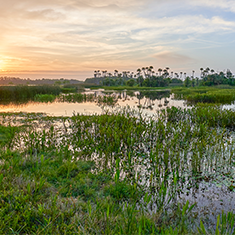
Wetlands play an important role in protecting biodiversity and managing stormwater. But for developers and landowners, they also represent regulatory boundaries that can fundamentally alter what gets built and where. Accurately identifying wetland limits is more than a technical requirement; it’s a key step in understanding project feasibility and timelines.
We sat down with Levi Keszey, an environmental scientist and ecologist based in Bowman’s Vermont office to unpack how our team approaches wetland delineation and why site planning in wetland-heavy areas demands both scientific precision and regulatory fluency.
Q: How does wetland delineation influence project feasibility?
A: Wetland delineation often determines whether development is even possible. Many parcels remain untouched because they’re mostly wetlands, something buyers and developers often don’t realize until we assess the site. Wetland boundaries are also critical in renewable energy siting, where open fields often turn out to be wetlands, limiting project viability.
One project that stands out is in Williston, VT, where we’re helping the town develop ADA-compliant biking and skiing trails on town land. The trails crisscross through wetlands and buffers, requiring a detailed regulatory process to balance accessibility goals with environmental protection.
Q: Speaking of regulations, how have recent changes to the definition of Waters of the United States affected wetland delineation?
A: There’s a lot of uncertainty because Supreme Court decisions and EPA guidance take time to influence local practice. Some state protections are stricter than federal ones, so we often work with state regulators who continue with business as usual despite federal ambiguity.
In practice, federal regulators look for a discrete connection between wetlands and navigable waters to determine jurisdiction. Sometimes it’s straightforward; other times it’s surprisingly complex, like deciding if a dug pond draining through a series of ditches counts as jurisdictional. This definition is recent and often subjective, making it hard to give clients a clear answer about permitting outcomes. In many states, wetlands that are not federally jurisdictional are considered significant and have local protections. Therefore, it is important to understand all the regulatory requirements at each level.
Q: How do developers generally work wetlands into their site plans?
A: Delineation and avoidance is the first priority, followed by minimizing impacts through design changes. If impacts are unavoidable, permits and mitigation are typically required. Whether jurisdiction lies at the federal or state level depends on the specific circumstances of the site. Permitting and mitigation processes can be time-consuming, so development schedules should account for potential delays. Initiating due diligence early, particularly to determine whether wetlands will require permitting, is essential to ensure compliance and to meet funding and project timelines.
Sometimes, mitigation can require incorporating listed species needs. For example, on one project, we have to design around a protected turtle species, ensuring it could cross driveways and access habitat. This means understanding local biology and incorporating that knowledge into engineering designs.
Q: How do wetland delineations impact developments, especially regarding options for developers?
A: It varies by state, but in many there are buffers around wetlands—if you want to impact uplands within a certain distance of a wetland, you need a permit and must justify the project’s necessity and design. The burden of proof is on the developer to show the impact is the best possible use of the land balanced with protecting natural resources.
As previously mentioned, avoidance is the first step. If impacts can’t be avoided, minimization comes next, like reducing parking spaces or altering designs to stay out of buffer zones. Finally, mitigation offsets unavoidable impacts, often through fees paid to organizations like Ducks Unlimited, which restore wetlands, or to mitigation banks that sell wetland credits. It is important to consider wetland constraints during the beginning phases of a project so engineers can incorporate design changes early in their process.
About Levi Keszey, PWS
Levi is an ecologist with more than a decade of field experience. He has contributed to projects in Vermont, Maine, New York and California, among others conducting wetland delineations, plant and wildlife surveys, habitat restoration and monitoring and resource mapping.
Bowman provides wetland delineations services across the United States.



